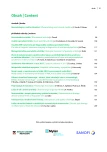Chronic pain therapy in inflammatory rheumatic diseases
Authors:
David Suchý 1,2; Jan Lejčko 3
Authors‘ workplace:
Oddělení klinické farmakologie FN Plzeň
1; Farmakologický ústav 2. LF UK, Praha
2; Ambulance pro léčbu bolesti Kliniky anesteziologie a resuscitace LF UK a FN Plzeň
3
Published in:
Vnitř Lék 2018; 64(2): 209-217
Category:
Reviews
Overview
Chronic pain is a common health problem related to most of inflammatory rheumatic disorders. It is pain that has persisted for at least 3 month and cannot be fully relieved by standard pain medication. 40–60 % of patients do not have adequate relief of their pain. Paramount in the management of chronic pain patients is assessment of the pain and its impact on physical and psychosocial functioning. Multidisciplinary and multimodal approach is of vital importance. Non-steroidal anti-rheumatic drugs (NSA) have been used mainly due to their strong analgesic effect, especially in the treatment of acute pain as well as their anti-inflammatory effect in the treatment of chronic i pain. Long-term systemic administration of NSA may be associated with a number of serious side effects, which significantly limit NSA use in long term therapy. Due to opiophobia, opioids are insufficiently used treatment modality. Knowledge about pain and its management, as well as an awareness of barriers to effective pain therapy, are important not only for pain specialists but also primary care physicians.
Key words:
chronic pain – non-steroidal antirheumatic drugs – opiophobia – opioids – pain assessment – paracetamol – rheumatoid arthritis
Sources
1. Breivik H, Collett B, Ventafridda V et al. Survey of chronic pain in Europe: Prevalence, impact on daily life, and treatment. Eur J Pain 2006; 10(4): 287. Dostupné z DOI: <http://dx.doi.org/10.1016/j.ejpain.2005.06.009>.
2. Buckalew N, Hairt MW, Morrow L et al. Chronic pain is associated with brain volume loss in older adults. Preliminary evidence. Pain 2008; 9(2): 240–248. Dostupné z DOI: <http://dx.doi.org/10.1111/j.1526–4637.2008.00412.x>.
3. Lejčko J. Možnosti léčby chronické bolesti. Med Pro Praxi 2009; 6(3): 150–154. Dostupné z WWW: <https://www.medicinapropraxi.cz/pdfs/med/2009/03/08.pdf>.
4. Hakl M, Lejčko J, Kozák J. Neopioidní analgetika. In: Hakl M et al. Léčba bolesti: současné přístupy k léčbě bolesti a bolestivých syndromů. 2nd ed. Mladá fronta: Praha 2013. ISBN 978–80–204–2902–5.
5. Opavský J. Lékové skupiny ve farmakoterapii bolesti. In: Opavský J. Bolest v ambulantní praxi: od diagnózy k léčbě častých bolestivých stavů. Maxdorf: Praha 2011. ISBN 978–80–7345–247–6.
6. Šléglová O. Analgetika. In: Pavelka K et al. Revmatologie. Maxdorf: Praha 2012. ISBN 978–80–7345–295–7.
7. Da Costa BR, Reichenbach S, Keller N et al. Effectiveness of non-steroidal anti-inflammatory drugs for the treatment of pain in knee and hip osteoarthritis: a network meta-analysis. Lancet 2017; 390(10090): e21-e33. Dostupné z DOI: <http://dx.doi.org/10.1016/S0140–6736(17)31744–0>.
8. Olejárová M. Současné postavení nesteroidních antirevmatik v terapii revmatických onemocnění. Remedia 2013; 23(6): 416–421.
9. Mallen SR, Essex MN, Zhang R. Gastrointestinal tolerability of NSAIDs in elderly patients: a pooled analysis of 21 randomized clinical trials with celekoxib and nonselective NSAIDs. Curr Med Res Opin 2011; 27(7):1359–66. Dostupné z DOI: <http://dx.doi.org/10.1185/03007995.2011.581274>.
10. Kriška M, Rybár I, Rovenský J. Interakcie nesteroidových antiflogistík a analgetík. Klin Farmakol Farm 2004; 18(2): 108–110.
11. Suchý D, Hromádka M. Analýza rizik léčby bolesti nesteroidními antirevmatiky a paracetamolem. Bolest 2015; 18(2): 81–87.
12. Rahme E, Barkun A, Nedie H et al. Hospitalizations for upper and lower GI events associated with traditional NSAIDs and acetaminophen among the elderly in Quebec, Canada. Am J Gastroenterol 2008; 103(4): 872–882. Dostupné z DOI: <http://dx.doi.org/10.1111/j.1572–0241.2008.01811.x>.
13. Chan FK, Wong VW, Suen BY et al. Combination of cyclooxygenase-2 inhibitor and a proton-pump inhibitor for preventive of recurrent ulcer bleeding in patients at very high risk: A double-blind, randomised trial. Lancet 2007; 369(9573): 1621–1626. Dostupné z DOI: <http://dx.doi.org/10.1016/S0140–6736(07)60749–1>.
14. Safety of non steroidal antiinflammatory drugs. SOS final report 2012. Dostupné z WWW: <http://www.sos-nsaids-project.org>.
15. Kearney PM, Baigent C, Godwin J et al. Do selective cyclooxygenase inhibitors and traditional non steroidal antiinflammatory drugs increase the risk of atherotrombosis? Meta-analysis of randomised trials. BMJ 2006; 332(7553): 1302–1308. Dostupné z DOI: <http://dx.doi.org/10.1136/bmj.332.7553.1302>.
16. Opinion of the committee for medicinal products for human use pursuant to article 5(3) of regulation (ec) no 726/2004, for nonselective non steroidal anti-inflammatory drugs (NSAIDs). EMEA/CHMP410051/2006. Dostupné z WWW: <http://www.ema.europa.eu/docs/en_GB/document_library/Other/2010/01/WC500054342.pdf>.
17. Horák P. Místo naproxenu mezi ostatními nesteroidními antirevmatiky používanými v léčbě bolesti a zánětu u nejčastějších revmatických chorob. Interní Med 2015; 17(5): 259–263.
18. Bhala N, Emberson J, Merhi A et al. Vascular and upper gastrointestinal effects of non-steroidal anti-inflammatorydrugs: meta-analyses of individual participant data from randomised trials. Lancet 2013; 382(9894): 769–779. Dostupné z DOI: <http://dx.doi.org/10.1016/S0140–6736(13)60900–9>.
19. Pavelka K. Doporučeni České revmatologické společnosti pro léčbu osteoatrózy kolenních, kyčelních a ručních kloubů. Čes Revmatol 2012; 20(3): 138–157.
20. Huskisson EC, Berry H, Gishen P et al. Effects of antiinflammatory drugs on the progression of osteoarthritis of the knee. LINK Study Group. Longitudinal Investigation of Nonsteroidal Antiinflammatory Drugs in Knee Osteoarthritis. J Rheumatol 1995; 22(10): 1941–1946.
21. Pavelka K. Doporučeni České revmatologické společnosti pro léčbu ankylozujici spondylitidy. Čes Revmatol 2012; 20(1): 4–11.
22. FDA. Drug safety information. Informace dostupné z WWW: <http:WWW.fda.gov/ /Drugs/Drug Safety/information by drug class/ucm165107.htm:2009>.
23. Portenoy RK. Opioid therapy for chronic nonmalignant pain: a review of the critical issues. J Pain Symptom Manage 1996; 11(4): 203–217.
24. Lejčko J. Machart S, Skalková H et al. Dlouhodobá léčba opioidy u chronické nenádorové bolesti. Bolest 2003; 6(3): 146–154.
25. Slíva J. Opioidní analgetika. In: Slíva J, Müller Závalová V, Patočková J. Moderní farmakoterapie pro první linii. Axonite: Praha 2015. ISBN 978–80–88046–00–4.
26. Hess L. Pethidin slaví 70 let. Remedia 2009; 19(3): 213–214.
Labels
Diabetology Endocrinology Internal medicineArticle was published in
Internal Medicine

2018 Issue 2
Most read in this issue
- Axial spondyloarthritis
- The role of magnetic resonance imaging in diagnostics of axial spondyloarthritis
- Idiopathic inflammatory myopathies
- Diffuse alveolar hemorrhage – acute, life-threatening situation in rheumatology
